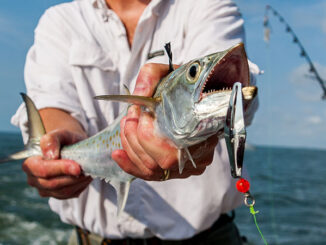
Casting to fall mackerel can fill your cooler quickly
September is a transition month at the North Carolina coast, as fish move from summer’s deep offshore haunts to nearshore waters. Spanish mackerel come in close this month.
The first “mullet blow” — a northeaster — drops water temperatures and puts inshore baitfish on the move. How the word gets to gamefish around offshore wrecks and reefs is anyone’s guess. But they head inshore to gorge on this moveable feast that lasts two months.
“The water will be cooler, and baitfish will be thick, on the beaches,” said guide Noah Lynk of Harkers Island (252-342-6911).
Veteran such as Lynk and local, Cape Lookout-area anglers know Spanish mackerel will be within a few long casts of the beaches. Moreover, these tasty fish that weighed 1 to 2 pounds during summer often add several pounds by September.
“Spanish mackerel school up more than they do in the summer,” he said. “They school in fall and winter like false albacore. It’s pretty similar to early spring. And they’ll be (mixed) with albies.”
Keys to finding mackerel include watching for diving birds and seeing alarmed baitfish schools scatter on the surface.
Baitfish such as glass minnows preoccupy Spanish. But they’ll still be alert for unusual movements — such as boats.
Casting is the way to go for Spanish mackerel in the fall
“Trolling for Spanish in the fall isn’t the best way,” Lynk said. “You can scatter them and make them go deep if you run through a school.”
Lynk prefers to get within casting distance and make long casts with jigs and spoons.
“We catch a lot of Spanish with metal jigs,” he said.
For equipment, Lynk likes a 7- to 7½-foot rod with a 3000 Series Okuma reel spooled with 12-pound braid and 3 feet of P-line fluorocarbon leader.
“The P-Line fluorocarbon has a coating that makes it soft and easy to tie, like monofilament,” said Lynk, who uses a surgeon’s knot to join his braid and leaders and a loop knot to tie his lures to the P-Line.
Jigs, which weigh between 1/2- and 1 ounce, will be only 2 to 3 inches long.
“Sea Striker Jig Fish work well, along with three new casting jigs made by the same company that makes Clarkspoons,” Lynk said. “Any (lure) that resembles a small glass minnow, 2 to 3 inches long, will catch Spanish.
“It depends on how you want to fish and how deep you want a lure to fall.
“The best way is to burn a jig across the surface. A lot of people think by burning a jig, I mean waiting until it hits the water, then start reeling. But that’s not what works best.
“When I cast to Spanish mackerel, I click over the bail and start winding before the lure hits the water. If you troll for Spanish, the boat has to run at least 6 knots. Spanish like fast-moving baits. But if you’re casting, it’s hard to wind a reel handle that fast, especially if you wait ‘til the lure hits the water.
“So I’m burning the reel before a cast lands. You’ll get more strikes that way.”
If the target is false albacore, anglers may choose to let lures sink and then wind. Fat Alberts often hang beneath Spanish mackerel schools.
“If you want Spanish though, you got to burn your reel,” Lynk said.



Be the first to comment